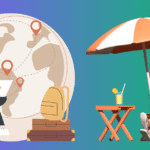Embracing the digital nomad lifestyle means you can run a business from a laptop anywhere in the world.
Building a business while traveling the world is more achievable today than ever before. Advancements in technology and global connectivity have given rise to a new generation of entrepreneurs who run digital-first businesses from beaches, cafes, and coworking spaces across the globe.
In fact, the number of digital nomads worldwide surpassed 50 million in 2025, up from just 35 million in 2023, a clear sign that location-independent entrepreneurship is booming. The key is choosing a business model that doesn’t tie you to one spot.
Online ventures like freelancing, consulting, e-commerce, blogging, digital marketing, or running a remote agency are ideal because they require no fixed location and can be operated from anywhere with an internet connection.
In this article, we’ll introduce you to popular digital-first business models that work well for travelers. From freelancing and e-commerce to coaching and SaaS, each section highlights what the model is, real-world examples, essential tools, pros and cons, and tips to get started. Let’s dive in!
Freelancing: Offer Your Skills from Anywhere
Freelancing is one of the most accessible ways to earn income as a digital nomad. It means offering your skills as services to clients on a project-by-project basis, rather than being tied to a single employer. Almost any skill can be freelanced – writing, graphic design, programming, digital marketing, virtual assistance, you name it. This model is popular among travelers because of its flexibility. You can work with clients globally, set your own hours, and take your work with you wherever you go. All you need is a laptop and a reliable internet connection.
Getting started: Create a strong online presence showcasing your portfolio and expertise. Join freelance marketplaces like Upwork, Freelancer, or Fiverr to find clients. These platforms let you bid on jobs and offer built-in tools for time tracking and secure payments, which can be very handy for working on the road. It’s also wise to network in remote work communities or on LinkedIn to find gig opportunities outside of platforms.
Pros of freelancing: You have a high degree of control over your schedule and workload. You can pick projects that interest you and pause or ramp up work depending on your travel plans. Startup costs are minimal – essentially just your existing skillset and a computer. This makes freelancing a quick way to start earning income online without a heavy investment.
Cons of freelancing: It can lack the income stability of a traditional job. Freelancers often deal with fluctuating workloads and irregular pay, since you’re not on a fixed monthly salary. You’ll need to continually market yourself and secure new clients to keep cash flowing. Additionally, you’re a one-person business – besides doing the work, you have to handle contracts, invoices, and your own benefits/taxes.
Tips for freelance success:
- Specialize and build a reputation: Focus on a niche or a set of services you do best. It’s easier to market yourself as (for example) a freelance web developer for e-commerce sites or a travel content writer than as a jack-of-all-trades. Over time, client reviews and a strong portfolio will help you command higher rates.
- Use the right platforms: Optimize your profiles on freelance sites. Highlight your skills and experience, and include a portfolio or case studies. Leverage platforms that fit your field – e.g., designers might use 99designs or Dribbble, writers might find gigs on ProBlogger job board, etc.
- Stay organized and professional: When you’re traveling, time zones and adventures can disrupt routines. Use project management tools, set a work schedule, and communicate clearly with clients about your availability. Delivering work on time (or early) and maintaining professionalism will earn you repeat business and referrals.
E-Commerce: Run an Online Store on the Road (Dropshipping & POD)
Running an e-commerce business while traveling is a popular choice, especially using models like dropshipping or print-on-demand that don’t require you to stock inventory. With e-commerce, you can sell products through an online store to customers anywhere in the world – all from your laptop. It’s thrilling to hear the notification of a new sale while you’re exploring a new country!
Dropshipping: This is an e-commerce model where you, as the store owner, do not hold any inventory yourself. Instead, you partner with suppliers who ship products directly to your customers when an order comes in. Your job is to handle the online storefront, marketing, and customer service, while the supplier takes care of fulfillment. For example, you could run a dropshipping store selling travel gadgets; when someone orders a backpack from your site, a supplier (perhaps in China or locally) ships it to the customer for you. Dropshipping is attractive for nomads because you don’t have to deal with warehousing or shipping logistics – it’s all handled behind the scenes. The key to success is finding a profitable niche and marketing effectively to stand out from the competition.
Print-on-Demand (POD): Print-on-demand is similar to dropshipping in that you don’t hold inventory, but it focuses on custom-designed products. You create designs (or hire a designer) for items like T-shirts, mugs, phone cases, tote bags, etc., and use a POD service to print and ship the product only after a customer orders it. For instance, as a traveling entrepreneur, you might design a line of T-shirts with slogans for surfers or digital nomads. When someone buys a shirt from your online store, a POD supplier (such as Printful or Teespring) will print your design on the shirt and send it to the customer. It’s a fantastic way to monetize your creativity without investing in bulk inventory.
Tools and platforms: Thanks to user-friendly platforms, setting up an online store is easier than ever. Services like Shopify allow you to create a professional e-commerce website in just a few clicks. You can integrate dropshipping apps (e.g., DSers or Modalyst) or connect to print-on-demand providers (e.g., Printful, Printify) directly with your store. Alternative options include WooCommerce (for WordPress users) or marketplace platforms like Amazon, eBay, and Etsy, where you can list products without creating your own site. Keep in mind that marketplaces come with their own fees and rules, but bring an existing audience, whereas your own store gives you more branding control.
Pros of e-commerce: An online store can run 24/7, making money even when you’re sleeping or trekking up a mountain. It’s highly scalable – a well-run store could handle hundreds of orders a day with the right systems. With dropshipping/POD, the upfront costs are relatively low since you only purchase a product when you’ve already made a sale. This means less financial risk and no hassle of managing physical stock. Also, you can be creative, whether it’s curating unique products or designing your own.
Cons of e-commerce: Competition in e-commerce is fierce, and finding a profitable niche or product takes research and patience. Margins in dropshipping can be thin, especially after marketing costs, so you’ll need to optimize for volume or higher-priced items. There’s also a lot to juggle – you must handle customer inquiries, coordinate with suppliers, and continually drive traffic to your site (often through paid ads, social media, or content marketing). If suppliers have delays or quality issues, it can reflect poorly on your business even if it’s out of your control. Additionally, while traveling, you must ensure you have reliable internet to manage orders and support tickets promptly.
Tips for traveling e-commerce entrepreneurs:
- Research and test niches: Before you commit fully, do market research. Use tools like Google Trends, Amazon sales data, or keyword research to gauge demand and competition for product ideas. Consider running a small pilot campaign for a product to test interest while you’re still in one place, so you can iron out any kinks in the process.
- Automate and outsource: Leverage automation tools for your store – for example, set up automated email confirmations, use virtual assistants to help with customer service, and employ inventory syncing apps. The more you can automate, the less you have to manually manage while you’re out exploring.
- Mind the logistics: Even though you’re not shipping items yourself, keep an eye on your suppliers. Maintain good communication with them and have a backup supplier if possible. When planning your travels, be mindful of time zones – you might need to adjust your working hours to overlap with suppliers or customer inquiries in major markets. Quality control is important too; order samples of your top products now and then to ensure the quality remains high.
Coaching and Consulting: Share Your Expertise Globally
If you have expertise in a particular field, coaching or consulting can be a rewarding way to earn income remotely. Coaches and consultants provide personalized advice, mentorship, or strategy to individuals or businesses.
The format could be one-on-one video calls, group coaching sessions, or project-based consulting work.
Many digital nomads monetize their professional backgrounds this way – for example, offering business consulting, marketing strategy, career coaching, fitness or yoga coaching, language lessons, and so on.
Because sessions can be conducted via video conferencing, you can coach clients from a beach bungalow or a mountain hostel just as easily as from a home office.
How to get started: Begin by defining your niche and the problem you solve. Perhaps you’re a certified fitness trainer, you could offer tailored workout and nutrition coaching online. Or if you have years of corporate marketing experience, you might consult small businesses on their marketing strategy. Set up a simple website or even just a professional LinkedIn profile detailing your services and testimonials. Use scheduling tools like Calendly to manage bookings and conduct sessions through Zoom or Skype. Many coaches also create free content (like a blog, newsletter, or YouTube tips) to build credibility and attract clients.
Pros: Coaching/consulting can be started with virtually no overhead – it’s your knowledge and time for a fee. You can charge premium rates if you offer high-value expertise, making this one of the higher-earning potential models once you establish a reputation. It’s incredibly fulfilling to directly help others and see their progress. Plus, you have the flexibility to schedule sessions around your travel plans (just be cautious of time zone differences).
Cons: Since coaching and consulting involve trading your time directly for money, your income is limited by your available hours. If you’re traveling in a timezone far from your clients, you might end up working odd hours to accommodate them. It also requires maintaining a reliable internet connection for live calls; patchy Wi-Fi on a remote island won’t cut it when you have a client session. Additionally, building up a client base can take time. You may need to offer some free introductory sessions or heavily network to get those first few clients and testimonials. Don’t forget that you’ll be responsible not only for the coaching itself but also for business tasks like marketing, scheduling, and invoicing.
Tips for remote coaches/consultants:
- Develop a signature offering: Create a structured program or clear deliverables for your coaching. For example, a life coach might offer an 8-week transformation program; a consultant might sell a fixed-price audit and report. Productizing your service makes it easier to market and gives clients a clear idea of what to expect.
- Leverage online platforms: Consider listing on coaching marketplaces (like Coach.me or Clarity.fm for business advice) to get in front of potential clients. If you’re open to longer-term engagements, platforms like Upwork also have many consulting gigs. Social media can be powerful too – sharing tips on Instagram or LinkedIn can attract an audience interested in your services.
- Set boundaries and manage time zones: Clearly communicate your availability to clients. If you’re traveling through Europe but most of your clients are in the US, you might choose to work evenings (which are morning/afternoon for the U.S.). Use tools like World Time Buddy to schedule across time zones. And be mindful to carve out personal/exploration time so you don’t end up working 24/7 – burnout helps no one.
Online Courses: Teach Once, Earn Over and Over
Creating an online course is a fantastic way to turn your knowledge into a passive income-generating product over time. Instead of coaching live (as above), you can package what you know into video lessons, PDFs, quizzes, and community forums, then sell access to this course repeatedly.
This digital product approach is highly nomad-friendly because, after the heavy lifting of course creation, you only need to focus on marketing and supporting students, which you can do asynchronously from anywhere.
How to create and sell courses: Identify a topic you’re skilled in that people are eager to learn. It could be anything: web development, graphic design, language learning, photography, or even how to be a successful digital nomad! Validate the demand by researching if similar courses exist and if people are asking questions about the topic online. Next, outline your curriculum and gather equipment to record your content – often just a good laptop camera or smartphone, a decent microphone, and slide presentations can do the job. Platforms like Teachable, Udemy, or Coursera make it simple to host your course and reach students. Alternatively, you could sell it on your own website using tools like LearnWorlds or Podia. Many course creators also supplement their income by offering an upsell, like group coaching, or by creating a series of courses.
Pros: Once the course is created, it can generate income with each new student who enrolls, without you having to deliver live each time. That means you can literally make sales while you sleep or while you’re on a 12-hour bus ride with no internet. It’s truly scalable – whether 10 people or 1,000 people take your course, you do the initial work once. Online courses also help establish you as an authority in your field, which can lead to other opportunities (like speaking engagements or consulting offers). If you price it right and tap into a hungry market, courses can become a substantial passive revenue stream.
Cons: Creating a quality course is hard work. It might take weeks or months of preparation, recording, and editing to produce a comprehensive course, and there’s no guarantee of sales. The upfront effort is significant, and it may be a while before you recoup that time investment. The online course marketplace is also very crowded now; depending on your niche, you might face stiff competition and need to spend on marketing or build an audience (via a blog, YouTube channel, email list, etc.) to find students. Additionally, you’ll need to update the content periodically, especially if your topic changes or software gets updated, etc. While you’re traveling, balancing course creation with enjoying your travels can be challenging – you might need to settle in one place for a month or two to film and focus.
Tips for online course success:
- Start with a “minimum viable course”: Instead of trying to create a 20-hour masterclass right off the bat, consider launching a shorter, focused course first. This allows you to test the waters, get feedback from students, and improve future courses. You can even run a live online workshop or webinar series initially, then turn those recordings into your first course.
- Leverage existing platforms for marketing: If you host on marketplaces like Udemy, take advantage of their audience and promotions, but note that you have less pricing control there. Alternatively, if you self-host, invest time in content marketing or even paid ads to promote your course. Partnering with affiliates (people who earn a commission to promote your course) can also help reach a wider audience.
- Engage with your students: One way to stand out is to offer great support. Even though the course is pre-recorded, be active in answering questions in the course forum or via email. Happy students may leave positive reviews or refer others. Also, success stories from your students become testimonials that boost your credibility.
Blogging & Content Creation: Turn Your Passion into Income
Many traveling entrepreneurs gravitate towards content creation as a way to share their journey and make money online. This category includes blogging, vlogging (video blogging), podcasting, and social media influencing.
The idea is to build an audience by creating valuable or entertaining content, then monetize that audience through various means such as advertising, sponsorships, affiliate marketing, or selling your own products/services.
For example, you might start a travel blog that chronicles your adventures and tips for fellow nomads, or a YouTube channel about learning languages while traveling, or an Instagram account showcasing digital nomad workspaces around the world.
How content creators make money: One common route is to monetize with ads – for instance, display ads on a blog (via Google AdSense or Mediavine) or YouTube ads that play before/during your videos. Affiliate marketing often goes hand-in-hand (recommending products or services and earning a commission on sales, which we’ll detail in the next section). Sponsored content is another avenue: companies might pay you to review a product, stay at a hotel, or mention their service if you have a sizable following. Some creators also create their own products (like e-books, presets, merchandise) or use crowdfunding/patronage models (Patreon, for example, where fans support you monthly in exchange for exclusive content).
Pros: Content creation lets you build a personal brand and potentially influence thousands of people – it can be very rewarding to inspire others. It aligns well with travel; your travels themselves often become material for content (like stunning photos, interesting stories). Over time, a successful blog or channel can earn passive income – e.g., a popular article or video can keep generating ad revenue or affiliate commissions long after it’s published. You also develop a wide range of skills (writing, photography, SEO, video editing, social media marketing) that are valuable in many fields. Importantly, you have creative freedom: you’re your own boss, creating content on your own terms.
Cons: In the beginning, it’s like shouting into the void – you will likely make little to no money until you’ve built up a significant audience, which can take many months or even years. Consistency is critical; you need to keep producing high-quality content regularly to grow, which is a lot of work with no immediate payoff. The space is saturated with bloggers and YouTubers, so it takes persistence to break through the noise. While traveling, you must juggle enjoying the moment with documenting it – sometimes you may feel you’re working all the time (filming, writing, editing) just to keep up. There’s also the pressure of algorithms and changing platform rules – a tweak in Google search or YouTube’s algorithm can impact your traffic drastically.
Tips for aspiring travel bloggers and creators:
- Find your niche and voice: Don’t be just another “travel blogger.” Maybe your angle is budget backpacking, or vegan food around the world, or remote work tips for programmers. By selecting a specific niche you are passionate about, you can attract a loyal audience and stand out as an authority. Your personal voice and storytelling also differentiate you; people often follow creators for who they are as much as for the content topic.
- Learn basic SEO and marketing: Great content alone isn’t enough; people have to find it. Optimize your blog posts for search engines by doing keyword research (using tools like Google Keyword Planner or Ubersuggest) so that your articles can rank when people search for those topics. Network with other creators, do guest posts or collaborations, and share your work on relevant forums or social media groups. Early on, every little bit of promotion helps to build momentum.
- Diversify and be patient: It helps to diversify your presence – e.g., maintain a blog and a YouTube channel and a podcast, so you’re not reliant on a single platform. However, only expand as you can handle; quality should trump quantity. Monetize in multiple ways (ads, affiliates, maybe a digital product of your own) so you have multiple income streams. And most importantly, be patient and persistent. Treat content creation as a long game – the first 6-12 months might see slow growth, but if you stick with it and continually improve your content, the results can compound over time.
Affiliate Marketing: Monetize Your Recommendations
Affiliate marketing is a popular online business model, especially among bloggers and content creators, but it can also stand on its own. The concept is simple: you promote other companies’ products or services with a unique referral link, and when someone purchases through your link, you earn a commission. It’s a form of performance-based marketing that’s well-suited for a nomadic lifestyle because you don’t have to create or deliver any products yourself – you’re simply the middleman (or woman) providing recommendations and directing buyers to sellers.
Common avenues for affiliate marketing include niche blogs or review websites (e.g., a gear review site that earns from Amazon affiliate links when readers buy gadgets), YouTube reviews, email newsletters sharing deals, or even social media (though on some platforms, you’ll need a business account to share clickable links). For digital nomads, a classic approach is integrating affiliate links into a content site, like a travel blog that includes affiliate links to hotels, tours, travel insurance, or Amazon products for travel gear.
Pros: Affiliate marketing can be a low-overhead way to generate passive income. You don’t handle inventory, customer service, or product creation – you focus on content and marketing. If your content (articles, videos, etc.) attracts traffic, those affiliate links can earn commissions in the background. It scales nicely: you can potentially earn while you’re out hiking or sightseeing, as your past content continues to drive sales. Many affiliate programs are free to join, so startup costs are essentially just your website (if you have one) and effort. It’s also flexible in that you can choose products that align with your interests or your audience’s needs, which keeps your work enjoyable.
Cons: Saturation and competition are big factors. Popular affiliate niches (tech gadgets, travel, finance, etc.) have a lot of players, so ranking your content and getting people to your links can be challenging. Commissions per sale can be quite small (for instance, Amazon’s rates might be 4% for most product categories), meaning you need volume or high-priced items to make a substantial income. There’s also a lack of control – the company can change the commission structure or terminate the program, leaving you scrambling (Amazon has infamously cut affiliate rates with little warning in the past). Trust is crucial; if you push junky products just for commission, you’ll lose credibility with your audience. Lastly, affiliate income can be unpredictable and dependent on external trends (e.g., a product you review goes out of stock or out of style, and those earnings vanish).
Tips for affiliate marketing success:
- Choose the right niche and products: Align your affiliate promotions with a specific niche where you can build authority. If you are a nomad who loves photography, for example, focusing on promoting camera gear and editing software makes sense, as your knowledge will be valued. Use products yourself whenever possible so you can give genuine recommendations. People can tell when a review is authentic versus just salesy.
- Content is king: The most successful affiliates often provide high-value content around the products – in-depth reviews, comparisons, tutorials, or personal stories of using the item. High-quality, SEO-optimized content will bring in steady organic traffic over time. Don’t just throw up link lists; focus on helping the reader, and the sales will follow.
- Diversify affiliate programs: Don’t put all your eggs in one basket. Sign up for multiple affiliate programs relevant to your niche. For instance, travel bloggers might join not just Amazon’s program, but also hotel booking affiliates (Booking.com, Airbnb), tour companies, travel insurance affiliates, etc. That way, if one program changes terms, your overall income is not hit as hard. Additionally, consider using an affiliate link management plugin (if on WordPress) to organize and cloak your links, making it easier to update them if needed. Always disclose your affiliate links to maintain transparency and trust with your audience.
SaaS and Micro-SaaS: Build a Scalable Online Product
For the more tech-savvy (or those willing to team up with developers), creating a Software as a Service (SaaS) product can be a highly rewarding online business.
SaaS means offering a software application or tool to users on a subscription or usage-fee basis, typically accessible via the internet. Think of services like an online design tool, a cloud bookkeeping system, or even a niche mobile app. Users pay to use the software, which you host and continually improve.
Micro-SaaS usually refers to a smaller-scale SaaS, often built and run by a solo founder or a tiny team, targeting a very specific niche or problem. Digital nomads have an advantage here: as remote workers themselves, they often spot pain points that other remote workers or businesses have, and can build solutions for them.
Why SaaS works for nomads: Once developed, a SaaS product can be operated from anywhere – the infrastructure is on cloud servers, your customers are spread globally, and everything from marketing to customer support can be done remotely. You’re essentially selling a digital product/service that can generate recurring revenue (monthly or yearly subscriptions) even when you’re not actively working at every moment. It’s a business that can scale massively without needing you to be in a fixed location, which is why many entrepreneurial nomads gravitate towards it.
Getting started: First, identify a problem that can be solved with software. It might be something you encounter often. For example, while freelancing, you notice the need for a better time-zone coordination tool for teams – that could spark a SaaS idea. Research the market to ensure your idea isn’t already overdone or, if it is, how you can do it differently/better. Next, either start building it yourself (if you have coding skills) or consider hiring developers or using no-code/low-code platforms for a prototype. The development phase can be intense; some nomads hunker down in a low-cost location for a few months to focus on building their MVP (Minimum Viable Product). After launch, you’ll need to invest in marketing (SEO, content marketing, maybe paid ads, or listing on software directories) to gain users. Platforms like Product Hunt or indie hacker communities can be helpful to get initial traction for indie SaaS projects.
Pros: A successful SaaS can bring in steady, recurring income, which is something many other models lack. You might wake up to the “ka-ching” of new subscriptions daily. Being subscription-based also boosts the value of your business; if you ever choose to sell the company, recurring revenue businesses often fetch higher valuations. SaaS products can run 24/7 and serve customers worldwide without direct intervention, especially if you invest in good onboarding and support resources. Moreover, you’re truly creating value by solving a problem, which can be quite fulfilling. There are numerous stories of micro-SaaS founders making a solid 5- or 6-figure monthly income while traveling the world, with just a handful of staff or none at all.
Cons: Let’s be honest – building software (that people will pay for) is challenging. It requires technical know-how or the funds to outsource it. The development and debugging process can take months or longer, during which you have to support yourself with no guarantee that the product will succeed. Running a SaaS also means ongoing responsibilities: maintenance, updates, and customer support. If something breaks, you’ll need to fix it, even if it’s 3 AM in your time zone. You might find yourself working odd hours occasionally to deploy fixes or assist a client, which can cut into travel fun. The competition in software is also global; depending on your idea, you might be up against well-funded startups. Finally, the cost of running a SaaS (servers, third-party integrations, etc.) is not zero, so you’ll have monthly expenses to cover. It’s not as immediate an income as freelancing – more of a long-term play.
Tips for aspiring SaaS nomads:
- Start lean and iterate: Don’t over-engineer version 1. Launch with a simplified set of features targeting the core problem. Get real user feedback as soon as possible and iterate. This lean startup approach saves you from building things nobody wants. For instance, you might launch a web app to test the concept before investing in a mobile app.
- Prioritize customer support and UX: Because you won’t be there in person, your software and support need to speak for you. Create documentation, tutorials, or even a community forum to help users help themselves. When customers do reach out for support, respond promptly and helpfully – this builds trust and reduces churn (cancellations). Using helpdesk tools or even chatbots can assist while you are offline. Remember, a happy user will stick around and maybe refer others, boosting that recurring revenue.
- Keep learning and be adaptable: The tech world evolves quickly. As a SaaS founder, you’ll need to stay updated on new technologies, security practices, and competitor movements. Be prepared to pivot if needed – perhaps your product gains traction with a different audience than expected, or users request a feature you hadn’t considered. The ability to adapt is crucial. On the flip side, know when to go heads-down despite travel distractions; sometimes you might pause your nomadic adventures to focus on a big update or to tackle a growth opportunity.
Remote Agency: Build a Business With a Distributed Team
Why stop at working solo when you can assemble a remote agency and tackle bigger projects? A remote agency is essentially a company that provides services (like marketing, design, software development, SEO, consulting, etc.) with a team that is entirely distributed.
As a digital nomad, you might start as a freelancer in a field and then expand by hiring other talented freelancers or remote employees to form an agency. This lets you take on more clients or larger contracts than you could alone, all while you continue to travel.
For instance, you might create a remote web design agency or a content marketing agency serving clients around the world, with team members in different countries collaborating online.
How it works: Running a remote agency means you’ll be focusing on both client work and business management. You’ll need to find clients (just like freelancing, but aiming for bigger deals), and also coordinate your team’s efforts. Thanks to cloud tools, this is very doable today. Communication and project management apps are your lifeline: Slack or Microsoft Teams for chat, Trello or Asana for task management, Google Drive or Notion for sharing documents, etc.. You might have designers in Asia, writers in Europe, and yourself meeting with a client on Zoom who is in North America – it’s pretty amazing when you think about it. Many remote agencies also never meet their clients in person; everything from proposals to deliverables is handled digitally.
Pros: A remote agency can grow beyond the limits of your personal time – you’re not limited to 24 hours in a day if you have a team working with you. This means your earning potential is higher; you could be managing multiple projects in parallel. It also adds credibility when pitching to larger clients if you can say “we” instead of “I” and demonstrate you have a team in place. Running an agency builds valuable leadership and management experience. From a lifestyle perspective, you still have no fixed office – your team is wherever you all are, which could include co-working spaces or home offices on different continents. If structured well, the business can even continue operating if you (the founder) take a week off, since your team can handle tasks, giving you a bit more freedom eventually. Scalability makes this a potentially lucrative option for nomads with an entrepreneurial drive.
Cons: Managing a team remotely comes with challenges. It’s tougher to ensure everyone is on the same page across time zones and cultural differences. You have to implement clear processes for how work is done, and sometimes invest in tools or systems to facilitate collaboration. As the boss, you’ll be dealing with not just client deliverables but also hiring, payments, and possibly conflicts or performance issues among your staff. There’s more overhead in terms of time and possibly cost – you might need to pay for software subscriptions, higher internet bills for lots of video calls, and of course, paying your team promptly, even if a client pays you late. Client acquisition is also an ongoing necessity; you might need to spend more effort on marketing your agency (through a professional website, case studies, perhaps even running ads or attending online networking events) compared to when you were just freelancing. Simply put, an agency is a full-fledged business with moving parts, and running it on the move requires excellent organization and discipline.
Tips for running a successful remote agency:
- Hire smart and build a culture: Bring on team members who not only have the skills but also are reliable and communicate well. One weak link can hurt a small remote team. Since you can’t have in-person meetups easily, foster a positive work culture through regular video meetings or even occasional meetups if possible (some agencies sponsor an annual team retreat). Make sure everyone understands the mission and values of the company.
- Delegate and trust your team: As a founder, especially if you started as a solo freelancer, it’s tempting to try to micromanage every detail. But to scale, you need to delegate. Trust your team with responsibilities, whether it’s having someone else handle initial client communications or lead a project. This not only frees you up but also empowers team members and helps them grow, which contributes to retention.
- Use contracts and manage finances carefully: When traveling, the last thing you want is a payment dispute or confusion over project scope. Always use clear contracts with clients, specifying deliverables, timelines, and payment terms. Consider using online contract and proposal tools (like HelloSign or Proposify) to streamline this. Keep track of your finances – you might use cloud accounting software (like QuickBooks Online or Xero) to stay on top of invoices and expenses. It’s wise to have a financial cushion, because an agency often has to pay contractors before clients pay their invoices. Good financial management will keep your remote business stable even as you roam.
Conclusion: Designing Your Location-Independent Business Lifestyle
Starting a business while traveling is a bold and exciting endeavor. As we’ve explored, there are numerous online business models suited to the digital nomad lifestyle – from freelancing and e-commerce to coaching, content creation, affiliate marketing, SaaS, and running a remote agency.
Each has its unique appeal, and the “right” one depends on your skills, interests, and how you envision your work-life balance on the road. Some, like freelancing, might let you start earning quickly, while others, like SaaS or blogging, are longer journeys that can pay off big in the long run.
A common thread among all these models is that they offer freedom, flexibility, and the potential for scalability – key ingredients for anyone seeking to break free from the office grind. But it’s important to remember that remote entrepreneurship is still entrepreneurship. Discipline, consistency, and continuous learning will be your travel companions, just as much as your backpack and passport. Working from a hammock is awesome, but it comes with the responsibility of managing your time and priorities when no one else is looking.
Finally, don’t be afraid to mix and match these models. Many digital nomads run hybrid businesses (for example, freelance consulting while also building a product, or blogging that supports an e-commerce store through traffic). Multiple income streams can add stability in the ever-changing landscape of remote work. As you embark on your journey, stay adaptable and open to new opportunities – the online world is always evolving, and new possibilities for location-independent income pop up all the time.
Inspiration meets practicality when you plan well: do your research, leverage the right tools, and set yourself up for success with good habits. Now is a great time to take the leap. So design that business plan, book that flight (or van or train), and embrace the adventure of being a traveling entrepreneur. With passion and persistence, you truly can build a thriving business and see the world at the same time. Here’s to your very own success story as a digital nomad entrepreneur – safe travels and happy hustling!
- Remote Startups: How to Lead a Global Team Successfully - 27 September 2025
- How the Creator Economy Is Changing Entrepreneurship - 27 September 2025
- Starting a Business While Traveling: Digital-First Models That Work - 27 September 2025











